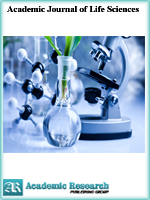Academic Journal of Life Sciences
Online ISSN: 2415-2137
Print ISSN: 2415-5217
Print ISSN: 2415-5217
Quarterly Published (4 Issues Per Year)

Archives
Volume 8 Number 2 June 2022
Analysis of Development in Solar Greenhouses
Authors: Abdeen Mustafa Omer
Pages: 14-32
DOI: doi.org/10.32861/ajls.82.14.32
Abstract
The move towards a de-carbonised world, driven partly by climate science and partly by the business opportunities it offers, will need the promotion of environmentally friendly alternatives, if an acceptable stabilisation level of atmospheric carbon dioxide is to be achieved. The use of natural resources that have not any air pollution or greenhouse gases and provides comfortable coexistence of human, livestock, and plants. The greenhouses require air conditioning process to control their temperature and relative humidity to suit specific plants. To achieve this goal, a novel air humidifier and/or dehumidifier systems using mop fans had been designed and employed in an experimental greenhouse to evaluate its performance under a controlled environment. The mop fans help to reduce the energy consumption of the greenhouse whilst providing a pleasant environment for the plants inside the greenhouse. The system was designed taking into account the meteorological conditions, which affect the environment inside the greenhouse. The performance of the system was monitored over a period of time by measuring the temperature and relative humidity of the greenhouse. Results of the monitoring have shown that the system was able to provide comfortable conditions (temperatures of 16-26oC and relative humidity of 65%) suitable for the plants grown in the experimental greenhouse. This device enables to minimise the temperature variation and, hence, avoided the hazard of any sudden climatic change inside the greenhouse.
Self-Esteem as Predictor of Post-Traumatic Stress among Victims of Human Trafficking in South-West Nigeria
Authors: Dennis Uba Donald ; Okeke Afamefefuna O.
Pages: 8-13
DOI: doi.org/10.32861/ajls.82.8.13
Abstract
The advent of human trafficking has become a global plague in the twentieth century. This study examined self-esteem as a predictor of Post-Traumatic stress among a group of selected victims of human trafficking. A correlational survey design was adopted in the study. The accidental sampling technique was used to select seventy-eight (78) victims of human trafficking who were in different zones of the National Agency for Trafficked Persons (NAPTIP). Post-traumatic Stress Scale, developed by Keane et al (1984) (α = .97) and the Inventory for Self-Esteem by Hudson, (1984) = (α. 92) was used to gather necessary information for the study. Two hypotheses were formulated and tested using an independent t-test and simple linear regression analysis. The results showed that self-esteem showed an inverse prediction on post-traumatic stress disorder (β = -.28 p < .01), and the scores of victims with low self–esteem (X) = 26.14, high self–esteem (X) = 20.44 were significantly different. The observed difference in the mean reached a significant level at t (53) = -3. 26, P<.05. Based on the findings of this study, it is recommended that the National Agency for Trafficked Persons and other humanitarian organizations should establish a clinical unit within their organizations to help victims learn and become psychologically resilient should engage victims into therapeutic and educational programs and using clinical interventions to help boost self-esteem, and self-awareness of these victims to reduce the trauma associated problems associated with the heinous activities of human trafficking.



